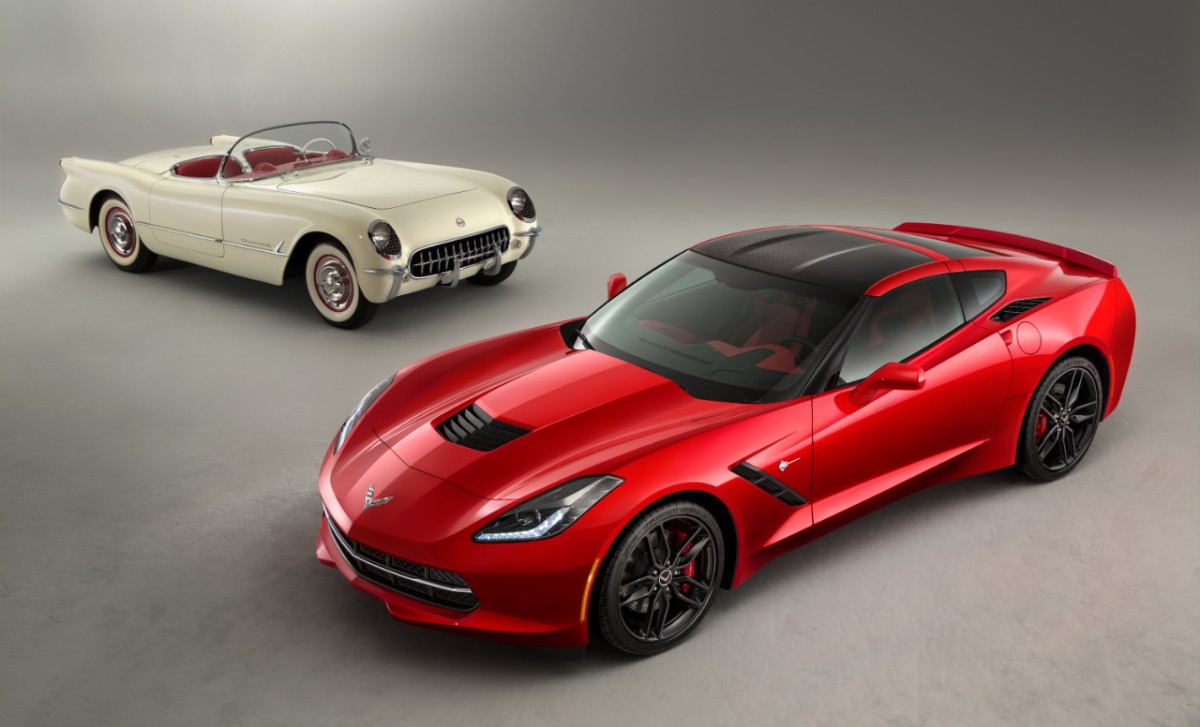IT'S HERE - The 7th Generation Corvette Breaks Cover!

Every decade or so for the last 60 years, something very special has happened in the American automotive landscape. 1953, 1963, 1968, 1984, 1997, 2005, and now, 2014, will bring a new generation Chevrolet Corvette off the line at Bowling Green, Kentucky.
Since 1953, Corvette has represented the absolute best that General Motors could build. That is not to say that every model was better than the last - the emission-strangled Corvettes of the early 1980's paled in comparison to those from a decade earlier - but every Corvette has been a showcase of just what GM was capable of in its day. (Don't leave, GNX fans, this is the Corvette's hour. We'll do a post on Black Air soon enough.)
.jpeg)
In 1953, the Corvette's fiberglass construction was unheard of. 1963 ushered in an era of style and racing prowess, from the single-year split window design to technological improvements like four-wheel disc brakes and independent rear suspension. After just five years, 1968 introduced the third generation at the height of the horsepower wars, with swooping fender lines worthy of the name "stingray" and roaring monster engines like the 7-liter, LT-1 427, rumored to have produced nearly 600 horsepower. 1984 (or 1983, depending on how you count it) saw the introduction of a new, wedge shaped fourth-generation Corvette. A product of its time, the fourth generation sported a digital dash festooned with buttons and engine enhancements aimed more at efficiency than performance. However, out of those troubled times came another legend - the quad-cam, all-aluminum engined ZR-1. Through the early nineties, as all of Detroit found its way back to the path of performance, the Corvette steadily improved, and in 1997 the C5 Corvette bowed to the cheers of enthusiasts everywhere. The fifth generation Corvette cemented a return to top-tier performance for the Corvette with the re-introduction of the storied Z06 nameplate. Running from 2005 to the present, the most recent, sixth-generation Corvette somehow managed to produce the most powerful model ever, the 600 horsepower (net!), supercharged, Nurburgring-storming ZR-1 despite GM's unfortunate exodus through bankruptcy and government ownership.

Now, tonight, in Detroit, a city valiantly reaching for a return to its own glory, the sheet has finally been pulled off the seventh generation of Chevrolet's flagship performance car. For millennia, peoples the world over have assigned special significance to the number seven. From what has been shown so far, this new Corvette reinforces that significance. Chevrolet has seen fit to resurrect the "Stingray" moniker (paired with a sweet new insignia), and with good reason. This latest generation displays sculpted body panels that carry the classic Stingray shape into the 21st century. In addition, the new grille contains a pattern of horizontal and vertical bars that harken back the very first Corvette of 1953.

While the exterior takes cues from past generations the interior makes no attempt to be anything except cutting edge. It may be cliched, but without exaggeration, when I was a small boy, I imagined that cars of the future would have interiors that looked like the one in the new Corvette. Among the aluminum angles and stitched leather, there is a seriously large touchscreen within easy reach of the driver, and another multifunction display planted squarely in the center of the instrument cluster, which seems to be capable of displaying everything from the tachometer to power curves and lap times. As if this wasn't enough visual stimulation to make any Millennial's eyes bleed, there also appears to be a multicolored HUD, showing that the technology GM has doggedly refined since the early nineties is finally coming into its own. Finally, GM has made a point of two new seating options. The support of the Corvette's seats has frequently been criticized, and the seventh generation introduces two seats: a standard set which should be please those who are looking to live with the Corvette on a daily basis, and a sharp-looking set of heavily bolstered, magnesium framed, track-day seats for hardcore drivers.

The details on the engine are still sparse, with GM stating only that it will have "at least" 450 horsepower and a 0-60 time "under four seconds". GM has been improving on the overhead-valve V8 engine for more than half a century now, so it should be expected that changes in that arena will be incremental rather than revolutionary. What has been shown is that the the seventh generation Corvette will have, suitably, a seven-speed manual transmission, which should keep the powerful V8 from sucking too much fuel at highway speeds. Most exciting is what looks like a single paddle-shifter on the steering column, which somehow activates automated rev-matching during gear changes, which should make every novice driver sound like a heel-and-toe virtuoso.
GM is justifiably very proud of this new Corvette, and we can't wait to see it in person at the Chicago Auto Show next month.
See the reveal here. (Skip to about 21:34 for the unveiling)
More information available at corvettestingray2014.com (site overloaded at time of this posting)
GM's official specifications are here.
A brief history of the Corvette can be read here (official) or here (unofficial).
All Images © General Motors
 Chicago
Chicago